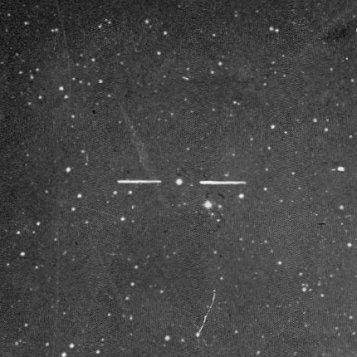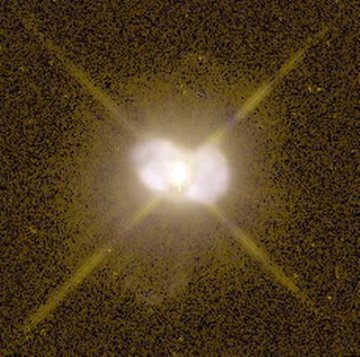IC 4997
"Indistinguishable from a star" (Curtis). IC 4997, in extreme
southeastern Sagitta (between the
classical figures of Sagitta and Delphinus), is one of several "stellar" planetary nebulae that to the eye are
physically so small or so far away (or both) that they just look
like stars. In Curtis's photo the nebula appears as no more than
a 10th magnitude dot. The category includes seven others with NGC
or IC numbers. The only way to tell them from stars is through
their spectra. Of the set, IC 4997, a most unusual object, is at
the top of the list of significance.
Small as it is, the great resolving power of the Hubble (see the
image at right) reveals an intricate bi-lobed structure seemingly
overwhelmed by a relatively brilliant 14th magnitude central star.
(The spikes on the Hubble image are artifacts of the telescope.)
The object has been resolved at radio frequencies as well. The
angular "diameter" depends on how you measure it and with what
instruments. An outer shell about 2.5 seconds of arc in size
surrounds a much more compact central region. The distance is not
known. At a statistical guess of 8000 light years, even the outer
nebula would be but a tenth of a light year wide.
The small size goes along with other extreme properties that
include a very high near-record-setting nebular temperature of
around 20,000 Kelvin (about double that of most nebulae) and a very
high density variously measured in the tens of thousands of atoms
per cubic centimeter up to 100,000 or more. Expanding at a rate of
20 kilometers per second (the outer region less), the dusty nebula
appears to be very young and recently formed, one estimate
suggesting less than 700 years ago. Consistently the star, still
heating, is yet relatively cool, with a temperature of just 49,000
Kelvin. Even that is a bit odd. IC 418,
for example, another young nebula, is larger and apparently farther
along its evolutionary path, yet has a cooler central star, making
IC 4997's star appear too hot for its age.
The most remarkable property of IC 4997 is its variability, which
is unique among bright nebulae. A sudden change in the spectrum
was noted in the 1960s that is usually ascribed to a drop in
nebular temperature resulting from youthful expansion. But that is
just a guess; variations in the central star may play a role too.
Radio observations have also noted changes in structure over
periods of not much more than a year. IC 4997, small as it is, is
clearly a nebula to keep our eye on, as it is telling us something
about how these marvelous objects are born and develop in their
youth.
Left: Image by H. D. Curtis from Publications of the Lick
Observatory, Volume 13, Part III, 1918. Right: Howard Bond
(STScI), NASA.



